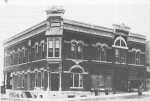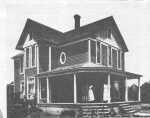Early McCook hospitals
Monday, July 2, 2012

McCook's first hospital, upper floors at Norris and B.
This past weekend, we were privileged to tour the magnificent newly renovated McCook Hospital and marveled at all the technological advances that the new hospital offers. Surely, this is a far cry from the valiant, though crude, attempts that were made by the early McCook doctors in bringing quality health care to people in our area. It seems like a good time to look back at some of McCook early hospitals, to see how far we've come since 1882.
Though McCook had doctors and drug stores from the very beginning, hospitals were considered somewhat of a luxury in the early days. In those early days operations of any sort were not at all commonplace, and those that were done were performed in the doctor's office, in the home, occasionally in hotel rooms. Babies were delivered at home.
In 1893 Dr. Spickelmeier had an "Institute," where people were invited to come for treatment of a wide array of ailments, from hemorrhoids to opium addiction. Room and board, $4-$6 per week, professional care and medicine $25 per week.

McCook General (Reid Hospital) 500 block Norris Avenue.
Dr. W. V. Gage opened McCook's first "hospital" (a five-bed facility) above the First National Bank on B Street in the 1890s, and it was in this location that he and Dr. Easterday performed the region's first appendix operation.
As early as 1904, there was a movement in McCook to provide a hospital for a growing population. But at a public meeting it was determined that the community needed both a library and an auditorium more than it needed a community hospital. It was generally felt that the private hospitals of several individuals were doing a good job.
One of these private hospitals in McCook (McCook General Hospital) was started by Dr. D. J. Reid in the 1000 block of West 1st Street in 1910. The community sentiment toward a "Community" Hospital changed abruptly when Dr. Reid died during the flu epidemic in 1918. Dr. Reid's widow and his former partner, Dr. Swaggert, vowed to keep the hospital open, but there was widespread fear that the facility would close, leaving McCook with no hospital service at all.

St. Catherine's Hospital 1930, West 4th & M Street.
It was at this point that the McCook Chamber of Commerce enlisted community leaders for their support toward a community hospital. Some of these leaders included Frank Real, W.M. Somerville, Frank Colfer, B.J. Brady, C.H. Boyle, E.C. Kelso, J.A, True, C.W. Kelley, and A.M. Speer. The resident priest at St. Patrick's Catholic Church, the Rev. Kunz, was able to negotiate with the Sisters of St. Catherine of Sienna, in Springfield, Kentucky, and an agreement was reached with those nuns to found a hospital in McCook. That order was well known for their hospital work, as well as for their teaching of nurses.
When the sisters arrived in McCook in 1921, a hospital fund drive was already underway. The community would provide half and the Dominican Sisters the other half of the total price of $75,000 for the new hospital.
Community support for the project was strong and enthusiastic. Articles in the Gazette were frequent. "A good up-to-date, well-equipped and well-managed hospital is one of the most pressing needs of the city. People are going to Denver, Omaha, or Hastings for such hospital treatment and for sick persons such a trip is inconvenient, dangerous, and a great expense."
And, "Generous donations assure its erection." Another article, "The Sisterhood is experienced in means, methods, and facilities for managing a hospital economically." But, the article added, "The hospital will be strictly non-sectarian, offering equally good care to persons of every denomination." Another article, " ... the hospital will have facilities for 40 patients and will be equipped with the most modern equipment."
The hospital committee had planned well, and with considerable foresight for future growth. Initially a central building was built, with a 50-bed capacity. Plans called for wings to be added, as needed, on each of the four corners of the building, eventually making a large, sprawling building resembling the letter X. Only two of the four addition wings were ever built.
The new St. Catherine of Sienna Hospital, on West Fourth St. (land donated by J.E. Kelley), was dedicated in September 1923. It was a beautiful facility, of which the city was justifiably proud. It contained 80 rooms, with 50 beds for patients. There were three operating rooms -- one for major operations, one for minor operations, and a third for eye-ear-nose-and throat work. The first surgery in the new building was performed on July 25, 1923. The X-ray equipment was referred to as "the very best in its line."
The first staff included Dr. R.R. Reed, Dr. G.A. DeMay, and Dr. Elizabeth Hohl. The Executive Committee for the new hospital included W.E. Knox, J.M. Willis, Sisters Pius and Odilia. The Nursing Committee was Dr. Kay, Dr. Easterday, and Dr. Swaggert (of the old McCook General Hospital).
At first, St. Catherine's Hospital was a teaching hospital, in addition to its patient load. The first class began its studies in 1924 and the first graduation exercises were held in September of 1927. A number of the Dominican Sisters completed their courses at the school and were qualified by the state to serve as nurses. However by 1927 space restrictions became too much and the school was disbanded, becoming affiliated with St. Elizabeth's Hospital in Lincoln.
In the first five years of its existence, 3,000 patients were treated at St. Catherine's Hospital. By 1930, the south wing was added to the hospital, at a cost of $40,000. In 1948 the north wing was added to the building, bringing the capacity of the hospital to 120 beds. In 1956, money from the Barnett estate was used to renovate the surgery rooms, redo the kitchen and provide a dining room.
Although charity work was part of the hospital's function, it wasn't encouraged. In a '30s article, the Gazette reported "Charity work wrecks a considerable hardship on the hospital, working as it is on a financial margin that will permit hardly anything beyond its budget. The hospital has difficulty in carrying the extra load always imposed when 'ol' hard times come a knockin' at the door' of people in the territory."
By the late '60s, it was apparent that more would have to be done to St. Catherine's. One writer noted that the hospital had been outdated by "government regulations, competition and Father Time."
Payments from federal programs, such as Medicare and Medicaid, now made up approximately 60 percent of the hospital's income, and their standards dictated that, among other things, there were an insufficient number of bathrooms, and the hallways were too narrow. When architects determined that changes required to make St. Catherine's legal would cost more than 50 percent of a new modern building, it was decided to abandon that facility and go with a new structure.
Though the relationship between the Dominican Nuns and the City of McCook had been extremely positive over the years there were changes in this regard as well. The Hospital Governing Board, operating in far off Kentucky, was inefficient. The Dominican Order was faced with a shrinking number of nuns and a lack of funds, which made the operation of the hospital difficult.
The Order urged that the community gradually assume the operation of the hospital and undertake the responsibility of building a new hospital -- without the nuns. An agreement was reached which transferred ownership of St. Catherine's to the Community Hospital Association. The Dominican Order was paid $3,400 per month for three years, plus $150,000 for equipment, which would be moved to the new hospital, in northeast McCook.
Thus, McCook said goodbye to the Sisters of St. Catherine of Sienna, a group that had served our community with skill, compassion, efficiency -- and love, for more than 50 years.
-- Source: McCook Gazette, Centennial Edition, 1882-1982

